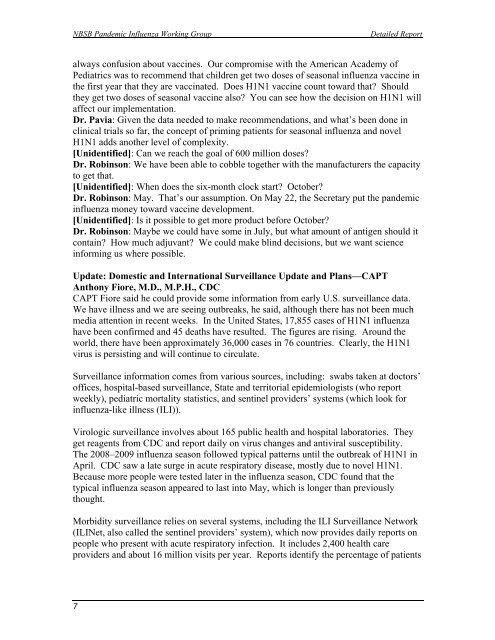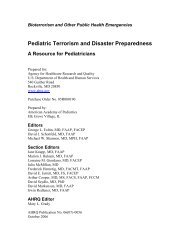H1N1 COUNTERMEASURES STRATEGY AND ... - PHE Home
H1N1 COUNTERMEASURES STRATEGY AND ... - PHE Home
H1N1 COUNTERMEASURES STRATEGY AND ... - PHE Home
You also want an ePaper? Increase the reach of your titles
YUMPU automatically turns print PDFs into web optimized ePapers that Google loves.
NBSB Pandemic Influenza Working Group<br />
Detailed Report<br />
always confusion about vaccines. Our compromise with the American Academy of<br />
Pediatrics was to recommend that children get two doses of seasonal influenza vaccine in<br />
the first year that they are vaccinated. Does <strong>H1N1</strong> vaccine count toward that? Should<br />
they get two doses of seasonal vaccine also? You can see how the decision on <strong>H1N1</strong> will<br />
affect our implementation.<br />
Dr. Pavia: Given the data needed to make recommendations, and what’s been done in<br />
clinical trials so far, the concept of priming patients for seasonal influenza and novel<br />
<strong>H1N1</strong> adds another level of complexity.<br />
[Unidentified]: Can we reach the goal of 600 million doses?<br />
Dr. Robinson: We have been able to cobble together with the manufacturers the capacity<br />
to get that.<br />
[Unidentified]: When does the six-month clock start? October?<br />
Dr. Robinson: May. That’s our assumption. On May 22, the Secretary put the pandemic<br />
influenza money toward vaccine development.<br />
[Unidentified]: Is it possible to get more product before October?<br />
Dr. Robinson: Maybe we could have some in July, but what amount of antigen should it<br />
contain? How much adjuvant? We could make blind decisions, but we want science<br />
informing us where possible.<br />
Update: Domestic and International Surveillance Update and Plans—CAPT<br />
Anthony Fiore, M.D., M.P.H., CDC<br />
CAPT Fiore said he could provide some information from early U.S. surveillance data.<br />
We have illness and we are seeing outbreaks, he said, although there has not been much<br />
media attention in recent weeks. In the United States, 17,855 cases of <strong>H1N1</strong> influenza<br />
have been confirmed and 45 deaths have resulted. The figures are rising. Around the<br />
world, there have been approximately 36,000 cases in 76 countries. Clearly, the <strong>H1N1</strong><br />
virus is persisting and will continue to circulate.<br />
Surveillance information comes from various sources, including: swabs taken at doctors’<br />
offices, hospital-based surveillance, State and territorial epidemiologists (who report<br />
weekly), pediatric mortality statistics, and sentinel providers’ systems (which look for<br />
influenza-like illness (ILI)).<br />
Virologic surveillance involves about 165 public health and hospital laboratories. They<br />
get reagents from CDC and report daily on virus changes and antiviral susceptibility.<br />
The 2008–2009 influenza season followed typical patterns until the outbreak of <strong>H1N1</strong> in<br />
April. CDC saw a late surge in acute respiratory disease, mostly due to novel <strong>H1N1</strong>.<br />
Because more people were tested later in the influenza season, CDC found that the<br />
typical influenza season appeared to last into May, which is longer than previously<br />
thought.<br />
Morbidity surveillance relies on several systems, including the ILI Surveillance Network<br />
(ILINet, also called the sentinel providers’ system), which now provides daily reports on<br />
people who present with acute respiratory infection. It includes 2,400 health care<br />
providers and about 16 million visits per year. Reports identify the percentage of patients<br />
7
















